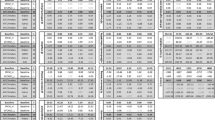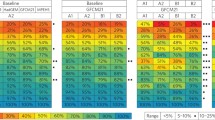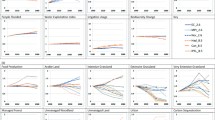Abstract
Integrated cross-sectoral impact assessments facilitate a comprehensive understanding of interdependencies and potential synergies, conflicts, and trade-offs between sectors under changing conditions. This paper presents a sensitivity analysis of a European integrated assessment model, the CLIMSAVE integrated assessment platform (IAP). The IAP incorporates important cross-sectoral linkages between six key European land- and water-based sectors: agriculture, biodiversity, flooding, forests, urban, and water. Using the IAP, we investigate the direct and indirect implications of a wide range of climatic and socio-economic drivers to identify: (1) those sectors and regions most sensitive to future changes, (2) the mechanisms and directions of sensitivity (direct/indirect and positive/negative), (3) the form and magnitudes of sensitivity (linear/non-linear and strong/weak/insignificant), and (4) the relative importance of the key drivers across sectors and regions. The results are complex. Most sectors are either directly or indirectly sensitive to a large number of drivers (more than 18 out of 24 drivers considered). Over twelve of these drivers have indirect impacts on biodiversity, forests, land use diversity, and water, while only four drivers have indirect effects on flooding. In contrast, for the urban sector all the drivers are direct. Moreover, most of the driver–indicator relationships are non-linear, and hence there is the potential for ‘surprises’. This highlights the importance of considering cross-sectoral interactions in future impact assessments. Such systematic analysis provides improved information for decision-makers to formulate appropriate adaptation policies to maximise benefits and minimise unintended consequences.


Similar content being viewed by others
Notes
CLimate change Integrated assessment Methodology for cross-Sectoral Adaptation and Vulnerability in Europe (www.climsave.eu)
See ESM 5 for the regional sensitivity statistics.
References
Audsley E, Pearn KR, Simota C et al (2006) What can scenario modelling tell us about future European scale agricultural land use, and what not? Environ Sci Pol 9:148–162
Audsley E, Trnka M, Sabaté S et al (2014) Interactively modelling land profitability to estimate European agricultural and forest land use under future scenarios of climate, socio-economics and adaptation. Climatic Change. doi:10.1007/s10584-014-1164-6
Aydinalp C, Cresser MS (2008) The effects of global climate change on agriculture. Am Eurasian J Agric Environ Sci 3(5):672–676
Bates BC, Kundzewicz ZW, Wu S, Palutikof JP (eds) (2008) Climate Change and Water. Technical Paper of the Intergovernmental Panel for Climate Change. IPCC Secretariat, Geneva, 210 pp
Berry PM, Rounsevell MDA, Harrison PA, Audsley E (2006) Assessing the vulnerability of agricultural land use and species climate change and the role of policy in facilitating adaptation. Environ Sci Pol 9(2):189–204
Berry PM, Brown S, Chen M et al. (2014) Cross-sectoral interactions of adaptation and mitigation measures. Clim Chang. doi:10.1007/s10584-014-1214-0
Brown AM (2001) A step-by-step guide to non-linear regression analysis of experimental data using a Microsoft Excel spreadsheet. Comput Methods Prog Biomed 65:191–200
Brown C, Brown E, Murray-Rust D et al (2014) Analysing uncertainties in climate change impact assessment across sectors and scenarios. Clim Chang. doi:10.1007/s10584-014-1133-0
Carter TR, Jones RN, Lu X et al (2007) New assessment methods and the characterisation of future conditions. In: Parry ML et al (eds) Climate change 2007: Impacts, adaptation and vulnerability. Cambridge University Press, Cambridge, pp 133–171
Ciais P, Reichstein M, Viovy N et al (2005) Europe-wide reduction in primary productivity caused by the heat and drought in 2003. Nature 437:529–533
Dubrovsky M, Trnka M, Holman IP et al (2014) Developing a reduced-form ensemble of climate change scenarios for Europe and its application to selected impact indicators. Clim Chang. doi:10.1007/s10584-014-1297-7
Dunford R, Harrison PA, Rounsevell MDA (2014) Exploring scenario and model uncertainty in cross-sectoral integrated assessment approaches to climate change impacts. Clim Chang. doi:10.1007/s10584-014-1211-3
EEA (2007) Climate change and water adaptation issues. European Environment Agency, EEA Technical Report, No. 2/2007, 110pp
Frieler K and the ISI-MIP Team (2013) Accounting for cross-sectoral linkages of climate change impacts based on multi-model projections. Geophysical Research Abstracts, EGU General Assembly 2013, 15:EGU2013–12601
Green RE, Harley M, Miles L et al (eds.) (2003) Global climate change and biodiversity. Summary of papers and discussion, Norwich, UK
Harremoes P, Turner RK (2001) Methods for integrated assessment. Reg Environ Chang 2:57–65
Harrison PA, Holman IP, Cojocaru G et al (2013) Combining qualitative and quantitative understanding for exploring cross-sectoral climate change impacts, adaptation and vulnerability in Europe. Reg Environ Chang 13:761–780
Harrison PA, Holman IP, Berry PM (2014a) Assessing cross-sectoral climate change impacts, vulnerability and adaptation: An Introduction to the CLIMSAVE project. Climatic Change (Editorial)
Harrison PA, Dunford R, Savin C et al (2014b) Cross-sectoral impacts of climate change and socio-economic change for multiple, European land- and water-based sectors. Clim Chang. doi:10.1007/s10584-014-1239-4
Hinkel J, Nicholls RJ, Vafeidis AT et al (2010) Assessing risk of and adaptation to sea-level rise in the European Union: an application of DIVA. Mitig Adapt Strateg Glob Change 15:703–719
Hinkel J, Lincke D, Vafeidis AT et al (2013) Coastal flood damage and adaptation costs under 21st century sea-level rise. PNAS 111(9):3292–3297
Holman IP, Harrison PA (eds.) (2012) Report describing the development and validation of the sectoral meta-models for integration into the IA Platform. CLIMSAVE Deliverable D2.2. http://www.climsave.eu/climsave/doc/Report_on_the_Meta-models.pdf. Accessed 09 Feb 2013
Holman IP, Rounsevell MDA, Shackley S et al (2005) A regional, multi-sectoral and integrated assessment of the impacts of climate and socio-economic change in the UK, Part I: Methodology. Clim Chang 71:9–41
Holman IP, Rounsevell MDA, Berry PM, Nicholls RJ (2008a) Development and application of participatory integrated assessment software to support local/regional impact and adaptation assessment. Clim Chang 90:1–4
Holman IP, Rounsevell MDA, Cojacaru G et al (2008b) The concepts and development of a participatory regional integrated assessment tool. Clim Chang 90(1–2):5–30
Kenny GJ, Ye W, Flux T, Warrick RA (2001) Climate variations and New Zealand agriculture: The CLIMPACTS system and issues of spatial and temporal scale. Environ Int 27(2–3):189–195
Kok K, Bärlund I, Flörke M et al (2014) European participatory scenario development: strengthening the link between stories and models. Clim Chang. doi:10.1007/s10584-014-1143-y
Lasdon LS, Waren AD, Jain A, Ratner M (1978) Design and testing of a generalised reduced gradient code for non-linear programming. ACM Trans. Math Softw 4:34–50
Lindner M, Maroschek M, Netherer S et al (2008) Climate change impacts, adaptive capacity, and vulnerability of European forest ecosystems. For Ecol Manag 259(4):698–709
Ludwig F, van Vliet MTH, Biemans H (2013) Climate change impacts on the water-food-energy nexus. IMAPCTS WORLD 2013, International Conference on Climate Change Effects, May 27–30, Potsdam, Germany
Matsuoka Y, Morita T, Kainuma M (2001) Integrated Assessment Model of Climate Change: The AIM Approach. In: Matsuno T, Kida H (eds), Present and Future of Modelling Global Environmental Change: Toward Integrated Modelling, pp.339–361
Millenium Ecosystem Assessment (2005) Ecosystems and Human Well-being: Synthesis. Island PRESS, Washington, DC
Mokrech M, Nicholls RJ, Richards JA et al (2008) Regional impact assessment of flooding under future climate and socio-economic scenarios for East Anglia and North West England. Clim Chang 90:31–55
Mokrech M, Kebede AS, Nicholls RJ et al (2014) An integrated approach for assessing flood impacts due to future climate and socio-economic conditions and the scope of adaptation in Europe. Clim Chang. doi:10.1007/s10584-014-1298-6
Moss RH, Edmonds JA, Hibbard KA et al (2010) The next generation of scenarios for climate change research and assessment. Nature 463:747–756
Nelson GC, Janetos A, Bennet E (2005) Drivers of change in ecosystem condition and services. In: Carpenter SR et al (eds) Scenarios Assessment of the Millennium Ecosystem Assessment. Island Press, London, UK, pp 173–222
Nicholls RJ, Kebede AS (2012) Indirect impacts of coastal climate change and sea-level rise: the UK example. Clim Pol 12:S28–S52
Ratto M, Castelletti A, Pagano A (2012) Emulation techniques for the reduction and sensitivity analysis of complex environmental models. Environ Model Softw 34:1–4
Saltelli A, Chan K, Scott M (eds) (2000) Sensitivity Analysis. Probability and Statistics Series. Wiley, New York
Toth FL, Bruckner T, Füssel H-M et al (2003) Integrated assessment of long-term climate policies. Part 1. Model presentation. Clim Chang 56:37–56
Wimmer F, Audsley E, Malsy M et al. (2014) Modelling the effects of cross-sectoral water allocation schemes in Europe. Clim Chang. doi:10.1007/s10584-014-1161-9
Acknowledgments
The research leading to these results has received funding from the European Commission Seventh Framework Programme under Grant Agreement No. 244031 (The CLIMSAVE Project; Climate change integrated assessment methodology for cross-sectoral adaptation and vulnerability in Europe; www.climsave.eu). CLIMSAVE is an endorsed project of the Global Land Project of the IGBP. MT was in addition supported through project: ‘Building Up a Multidisciplinary Scientific Team Focussed on Drought’, no. CZ.1.07/2.3.00/20.0248.
Author information
Authors and Affiliations
Corresponding author
Additional information
This article is part of a Special Issue on “Regional Integrated Assessment of Cross-sectoral Climate Change Impacts, Adaptation, and Vulnerability” with Guest Editors Paula A. Harrison and Pam M. Berry.
Electronic supplementary material
Below is the link to the electronic supplementary material.
ESM 1
(DOCX 918 kb)
Rights and permissions
About this article
Cite this article
Kebede, A.S., Dunford, R., Mokrech, M. et al. Direct and indirect impacts of climate and socio-economic change in Europe: a sensitivity analysis for key land- and water-based sectors. Climatic Change 128, 261–277 (2015). https://doi.org/10.1007/s10584-014-1313-y
Received:
Accepted:
Published:
Issue Date:
DOI: https://doi.org/10.1007/s10584-014-1313-y




